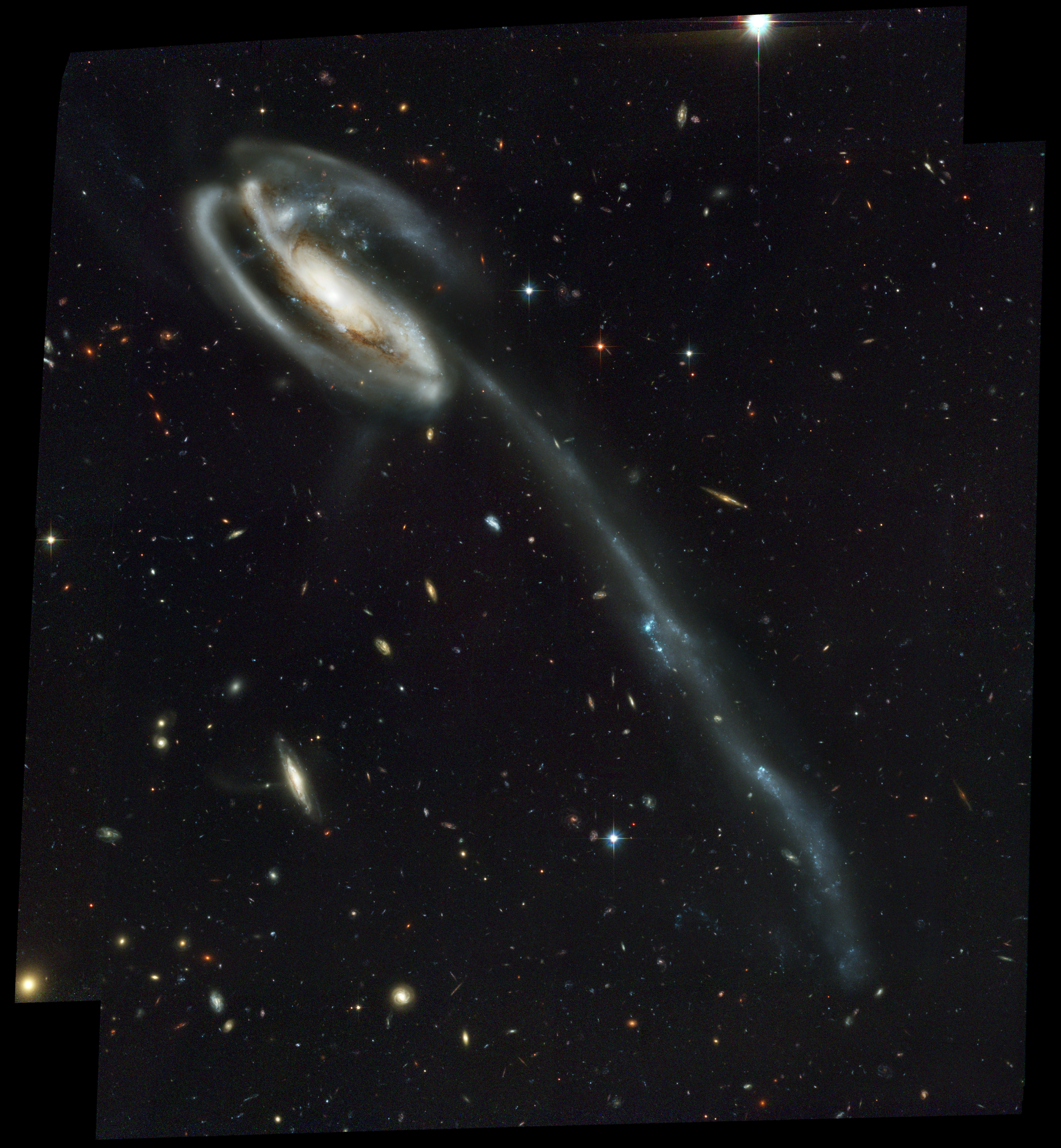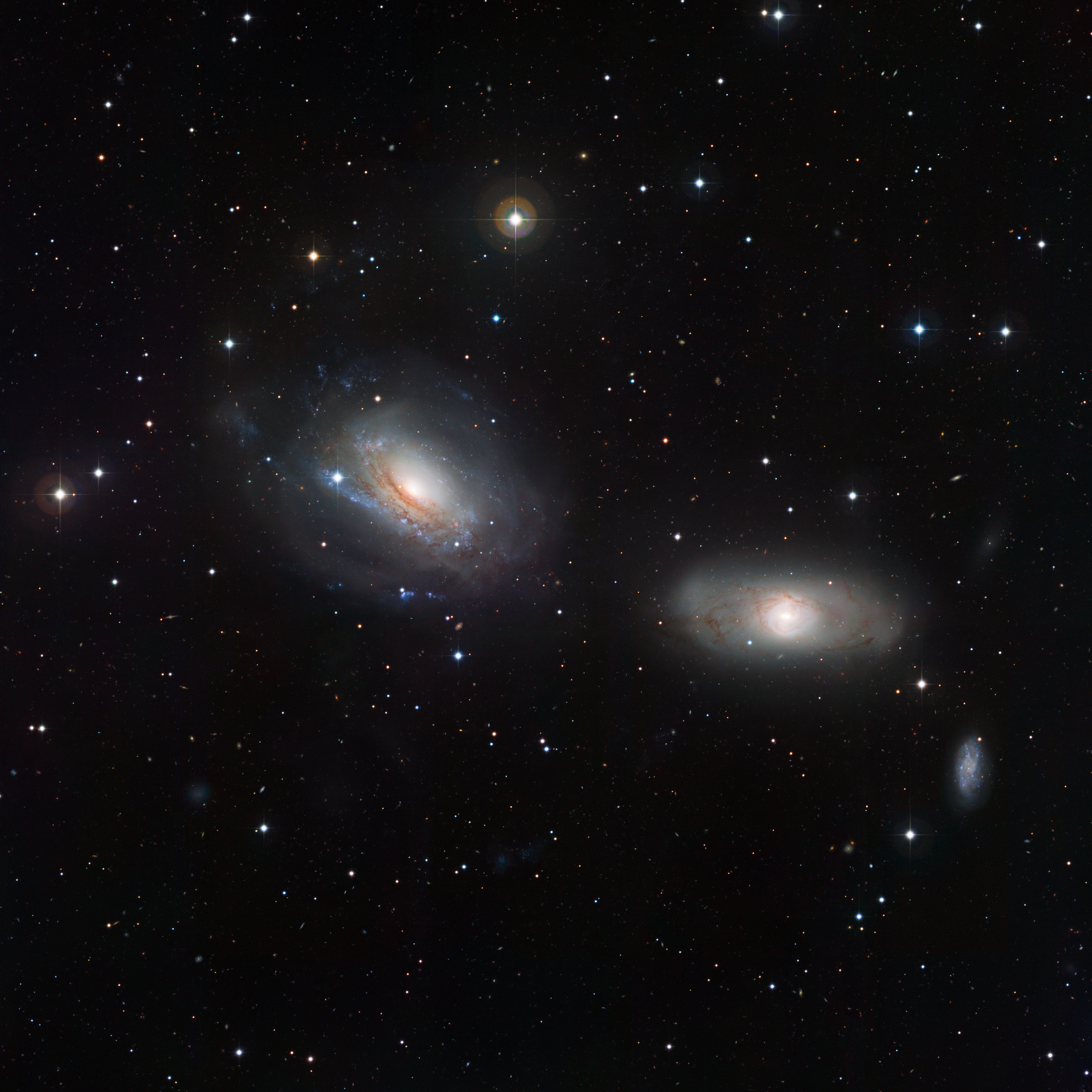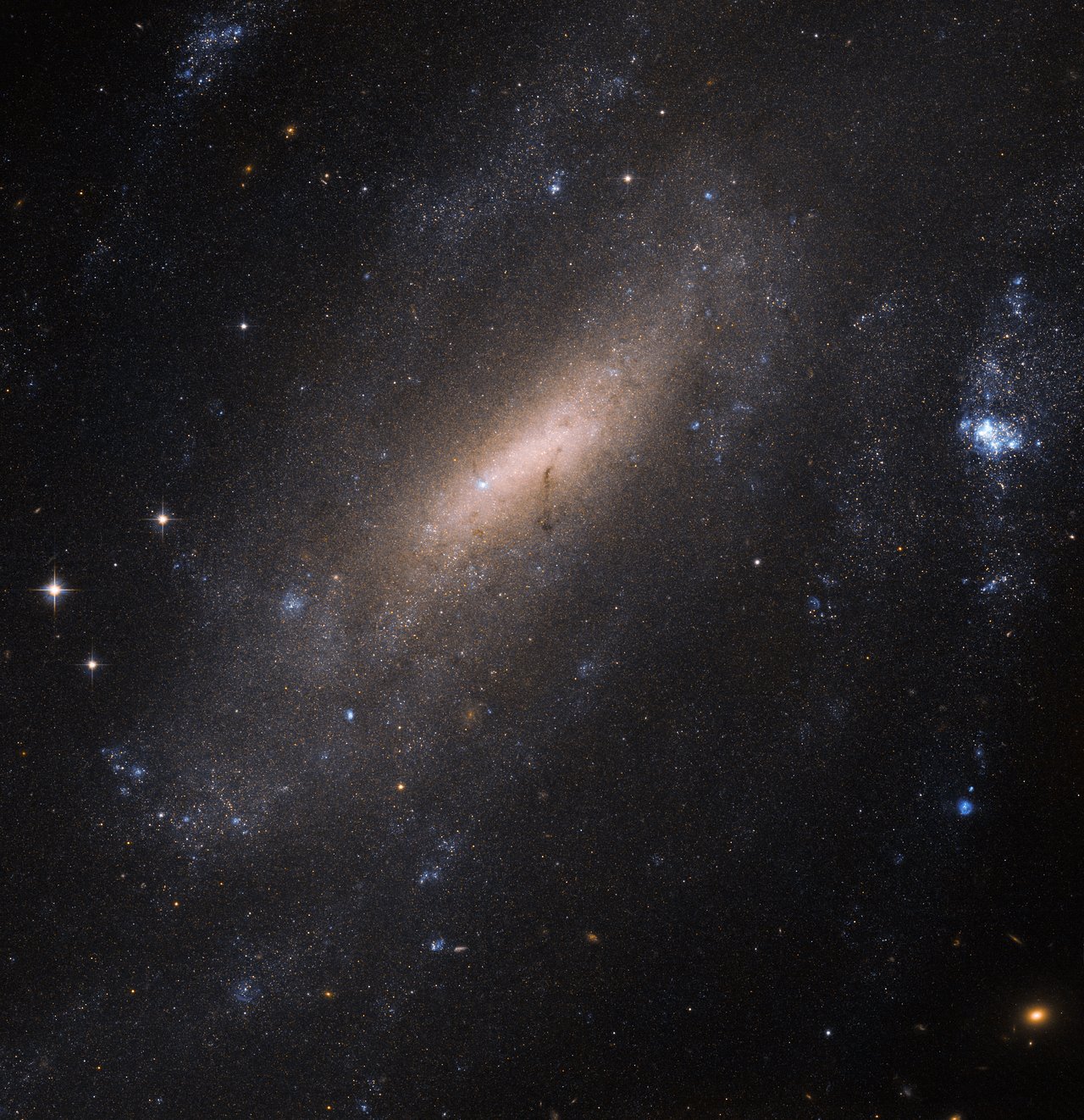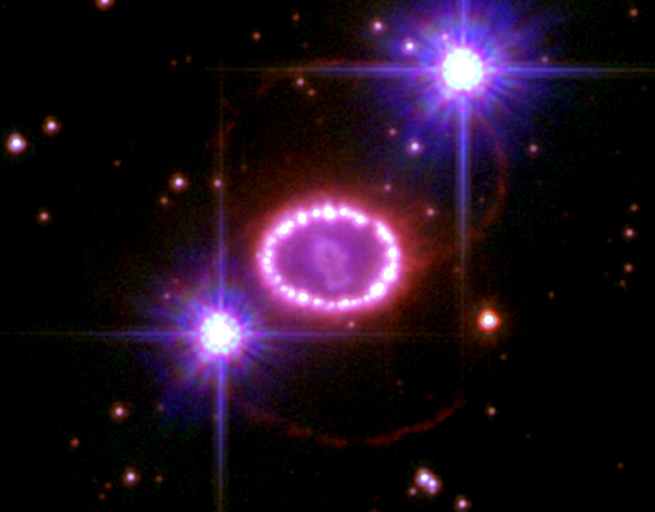|
NGC 3432
NGC 3432 is an edge-on spiral galaxy that can be found in the northern constellation of Leo Minor. It was discovered by German-British astronomer William Herschel on March 19, 1787. This galaxy is located at a distance of from the Milky Way. It is interacting with UGC 5983, a nearby dwarf galaxy, and features tidal filaments and intense star formation. Because of these features, it was listed in Halton Arp's Atlas of Peculiar Galaxies. The morphological classification of NGC 3432 is SB(s)m, which indicates this is a barred Magellanic spiral galaxy (SB) with no inner ring structure (s) and an irregular appearance (m). The galaxy is inclined at an angle of to the plane of the sky with its major axis along a positional angle of 38°, which means it is being viewed from nearly edge-on. It is interacting with the companion galaxy UGC 5983, which is creating features that extend outside the galactic plane, as well as an extended halo of radio emission. The shape of the galaxy is dis ... [...More Info...] [...Related Items...] OR: [Wikipedia] [Google] [Baidu] |
Sloan Digital Sky Survey
The Sloan Digital Sky Survey or SDSS is a major multi-spectral imaging and spectroscopic redshift survey using a dedicated 2.5-m wide-angle optical telescope at Apache Point Observatory in New Mexico, United States. The project began in 2000 and was named after the Alfred P. Sloan Foundation, which contributed significant funding. A consortium of the University of Washington and Princeton University was established to conduct a redshift survey. The Astrophysical Research Consortium (ARC) was established in 1984 with the additional participation of New Mexico State University and Washington State University to manage activities at Apache Point. In 1991 the Sloan Foundation granted the ARC funding for survey efforts and the construction of equipment to carry out the work.. Background At the time of its design, the SDSS was a pioneering combination of novel instrumentation as well as data reduction and storage techniques that drove major advances in astronomical observations, di ... [...More Info...] [...Related Items...] OR: [Wikipedia] [Google] [Baidu] |
Tidal Tail
A tidal tail is a thin, elongated region of stars and interstellar gas that extends into space from a galaxy. Tidal tails occur as a result of galactic tide forces between interacting galaxies. Examples of galaxies with tidal tails include the Tadpole Galaxy and the Mice Galaxies. Tidal forces can eject a significant amount of a galaxy's gas into the tail; within the Antennae Galaxies, for example, nearly half of the observed gaseous matter is found within the tail structures. Within those galaxies which have tidal tails, approximately 10% of the galaxy's stellar formation takes place in the tail. Overall, roughly 1% of all stellar formation in the known universe occurs within tidal tails. Some interacting galaxy pairs have two distinct tails, as is the case for the Antennae Galaxies, while other systems have only one tail. Most tidal tails are slightly curved due to the rotation of the host galaxies. Those that are straight may actually be curved but still appear to be stra ... [...More Info...] [...Related Items...] OR: [Wikipedia] [Google] [Baidu] |
Principal Galaxies Catalogue Objects
Principal may refer to: Title or rank * Principal (academia), the chief executive of a university ** Principal (education), the office holder/ or boss in any school * Principal (civil service) or principal officer, the senior management level in the UK Civil Service * Principal dancer, the top rank in ballet * Principal (music), the top rank in an orchestra Law * Principal (commercial law), the person who authorizes an agent ** Principal (architecture), licensed professional(s) with ownership of the firm * Principal (criminal law), the primary actor in a criminal offense * Principal (Catholic Church), an honorific used in the See of Lisbon Places * Principal, Cape Verde, a village * Principal, Ecuador, a parish Media * ''The Principal'' (TV series), a 2015 Australian drama series * ''The Principal'', a 1987 action film * Principal (music), the lead musician in a section of an orchestra * Principal photography, the first phase of movie production * "The Principal", a song on ... [...More Info...] [...Related Items...] OR: [Wikipedia] [Google] [Baidu] |
UGC Objects
UGC may refer to: Science and technology * Universal gravitational constant G, in physics * Uppsala General Catalogue, an astronomical catalogue of galaxies * UGC, a codon for cysteine * Unique games conjecture In computational complexity theory, the unique games conjecture (often referred to as UGC) is a conjecture made by Subhash Khot in 2002. The conjecture postulates that the problem of determining the approximate ''value'' of a certain type of gam ..., a conjecture in computational complexity Organisations * UGC (cinema operator), a European cinema chain, formerly Union Générale Cinématographique * UGC Fox Distribution, a former French-American film production company formed in 1995 * Union Graduate College, Schenectady, New York * United Grain Company, a Russian grain trading company based in Moscow * University Grants Commission (other) * University Grants Committee (other) * UnitedGlobalCom, former name of the cable TV operator Liberty Global * Un ... [...More Info...] [...Related Items...] OR: [Wikipedia] [Google] [Baidu] |
NGC Objects
The ''New General Catalogue of Nebulae and Clusters of Stars'' (abbreviated NGC) is an astronomical catalogue of deep-sky objects compiled by John Louis Emil Dreyer in 1888. The NGC contains 7,840 objects, including galaxies, star clusters and emission nebulae. Dreyer published two supplements to the NGC in 1895 and 1908, known as the ''Index Catalogues'' (abbreviated IC), describing a further 5,386 astronomical objects. Thousands of these objects are best known by their NGC or IC numbers, which remain in widespread use. The NGC expanded and consolidated the cataloguing work of William and Caroline Herschel, and John Herschel's ''General Catalogue of Nebulae and Clusters of Stars''. Objects south of the celestial equator are catalogued somewhat less thoroughly, but many were included based on observation by John Herschel or James Dunlop. The NGC contained multiple errors, but attempts to eliminate them were made by the ''Revised New General Catalogue'' (RNGC) by Jack W. Sulenti ... [...More Info...] [...Related Items...] OR: [Wikipedia] [Google] [Baidu] |
Interacting Galaxies
Interacting galaxies (''colliding galaxies'') are galaxies whose gravitational fields result in a disturbance of one another. An example of a minor interaction is a satellite galaxy disturbing the primary galaxy's spiral arms. An example of a major interaction is a galactic collision, which may lead to a galaxy merger. Satellite interaction A giant galaxy interacting with its satellites is common. A satellite's gravity could attract one of the primary's spiral arms. Alternatively, the secondary satellite can dive into the primary galaxy, as in the Sagittarius Dwarf Elliptical Galaxy diving into the Milky Way. That can possibly trigger a small amount of star formation. Such orphaned clusters of stars were sometimes referred to as "blue blobs" before they were recognized as stars. Galaxy collision Colliding galaxies are common during galaxy evolution. The extremely tenuous distribution of matter in galaxies means these are not collisions in the traditional sense of the w ... [...More Info...] [...Related Items...] OR: [Wikipedia] [Google] [Baidu] |
Barred Spiral Galaxies
A barred spiral galaxy is a spiral galaxy with a central bar-shaped structure composed of stars. Bars are found in about two thirds of all spiral galaxies, and generally affect both the motions of stars and interstellar gas within spiral galaxies and can affect spiral arms as well. The Milky Way Galaxy, where the Solar System is located, is classified as a barred spiral galaxy. Edwin Hubble classified spiral galaxies of this type as "SB" (spiral, barred) in his Hubble sequence and arranged them into sub-categories based on how open the arms of the spiral are. SBa types feature tightly bound arms, while SBc types are at the other extreme and have loosely bound arms. SBb-type galaxies lie in between the two. SB0 is a barred lenticular galaxy. A new type, SBm, was subsequently created to describe somewhat irregular barred spirals, such as the Magellanic Clouds, which were once classified as irregular galaxies, but have since been found to contain barred spiral structures. Among othe ... [...More Info...] [...Related Items...] OR: [Wikipedia] [Google] [Baidu] |
California Institute Of Technology
The California Institute of Technology (branded as Caltech or CIT)The university itself only spells its short form as "Caltech"; the institution considers other spellings such a"Cal Tech" and "CalTech" incorrect. The institute is also occasionally referred to as "CIT", most notably in its alma mater, but this is uncommon. is a private research university in Pasadena, California. Caltech is ranked among the best and most selective academic institutions in the world, and with an enrollment of approximately 2400 students (acceptance rate of only 5.7%), it is one of the world's most selective universities. The university is known for its strength in science and engineering, and is among a small group of institutes of technology in the United States which is primarily devoted to the instruction of pure and applied sciences. The institution was founded as a preparatory and vocational school by Amos G. Throop in 1891 and began attracting influential scientists such as George Ellery H ... [...More Info...] [...Related Items...] OR: [Wikipedia] [Google] [Baidu] |
Core Collapse Supernova
A supernova is a powerful and luminous explosion of a star. It has the plural form supernovae or supernovas, and is abbreviated SN or SNe. This transient astronomical event occurs during the last evolutionary stages of a massive star or when a white dwarf is triggered into runaway nuclear fusion. The original object, called the ''progenitor'', either collapses to a neutron star or black hole, or is completely destroyed. The peak optical luminosity of a supernova can be comparable to that of an entire galaxy before fading over several weeks or months. Supernovae are more energetic than novae. In Latin, ''nova'' means "new", referring astronomically to what appears to be a temporary new bright star. Adding the prefix "super-" distinguishes supernovae from ordinary novae, which are far less luminous. The word ''supernova'' was coined by Walter Baade and Fritz Zwicky in 1929. The last supernova to be directly observed in the Milky Way was Kepler's Supernova in 1604, appeari ... [...More Info...] [...Related Items...] OR: [Wikipedia] [Google] [Baidu] |
Supernova Imposter
Supernova impostors are stellar explosions that appear at first to be a supernova but do not destroy their progenitor stars. As such, they are a class of extra-powerful novae. They are also known as Type V supernovae, Eta Carinae analogs, and giant eruptions of luminous blue variables (LBV). Appearance, origin and mass loss Supernova impostors appear as remarkably faint supernovae of spectral type IIn—which have hydrogen in their spectrum and narrow spectral lines that indicate relatively low gas speeds. These impostors exceed their pre-outburst states by several magnitudes, with typical peak absolute visual magnitudes of −11 to −14, making these outbursts as bright as the most luminous stars. The trigger mechanism of these outbursts remains unexplained, though it is thought to be caused by violating the classical Eddington luminosity limit, initiating severe mass loss. If the ratio of radiated energy to kinetic energy is near unity, as in Eta Carinae, then we might expect ... [...More Info...] [...Related Items...] OR: [Wikipedia] [Google] [Baidu] |
Eta Carinae
Eta Carinae (η Carinae, abbreviated to η Car), formerly known as Eta Argus, is a stellar system containing at least two stars with a combined luminosity greater than five million times that of the Sun, located around distant in the constellation Carina. Previously a 4th-magnitude star, it brightened in 1837 to become brighter than Rigel, marking the start of its so-called "Great Eruption". It became the second-brightest star in the sky between 11 and 14 March 1843 before fading well below naked eye visibility after 1856. In a smaller eruption, it reached 6th magnitude in 1892 before fading again. It has brightened consistently since about 1940, becoming brighter than magnitude 4.5 by 2014. At declination −59° 41′ 04.26″, Eta Carinae is circumpolar from locations on Earth south of latitude 30°S, (for reference, the latitude of Johannesburg is 26°12′S); and is not visible north of about latitude 30°N, just south of Cairo, which is at a latitude ... [...More Info...] [...Related Items...] OR: [Wikipedia] [Google] [Baidu] |
Type IIn Supernova
A Type II supernova (plural: ''supernovae'' or ''supernovas'') results from the rapid collapse and violent explosion of a massive star. A star must have at least 8 times, but no more than 40 to 50 times, the mass of the Sun () to undergo this type of explosion. Type II supernovae are distinguished from other types of supernovae by the presence of hydrogen in their spectra. They are usually observed in the spiral arms of galaxies and in H II regions, but not in elliptical galaxies; those are generally composed of older, low-mass stars, with few of the young, very massive stars necessary to cause a supernova. Stars generate energy by the nuclear fusion of elements. Unlike the Sun, massive stars possess the mass needed to fuse elements that have an atomic mass greater than hydrogen and helium, albeit at increasingly higher temperatures and pressures, causing correspondingly shorter stellar life spans. The degeneracy pressure of electrons and the energy generated by ... [...More Info...] [...Related Items...] OR: [Wikipedia] [Google] [Baidu] |





.jpg)



